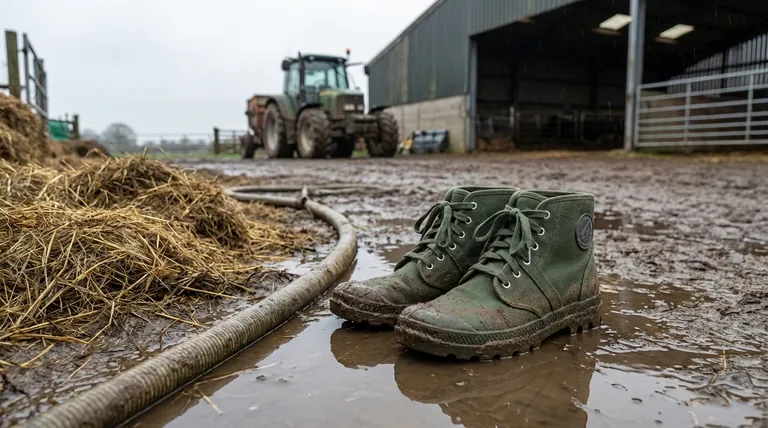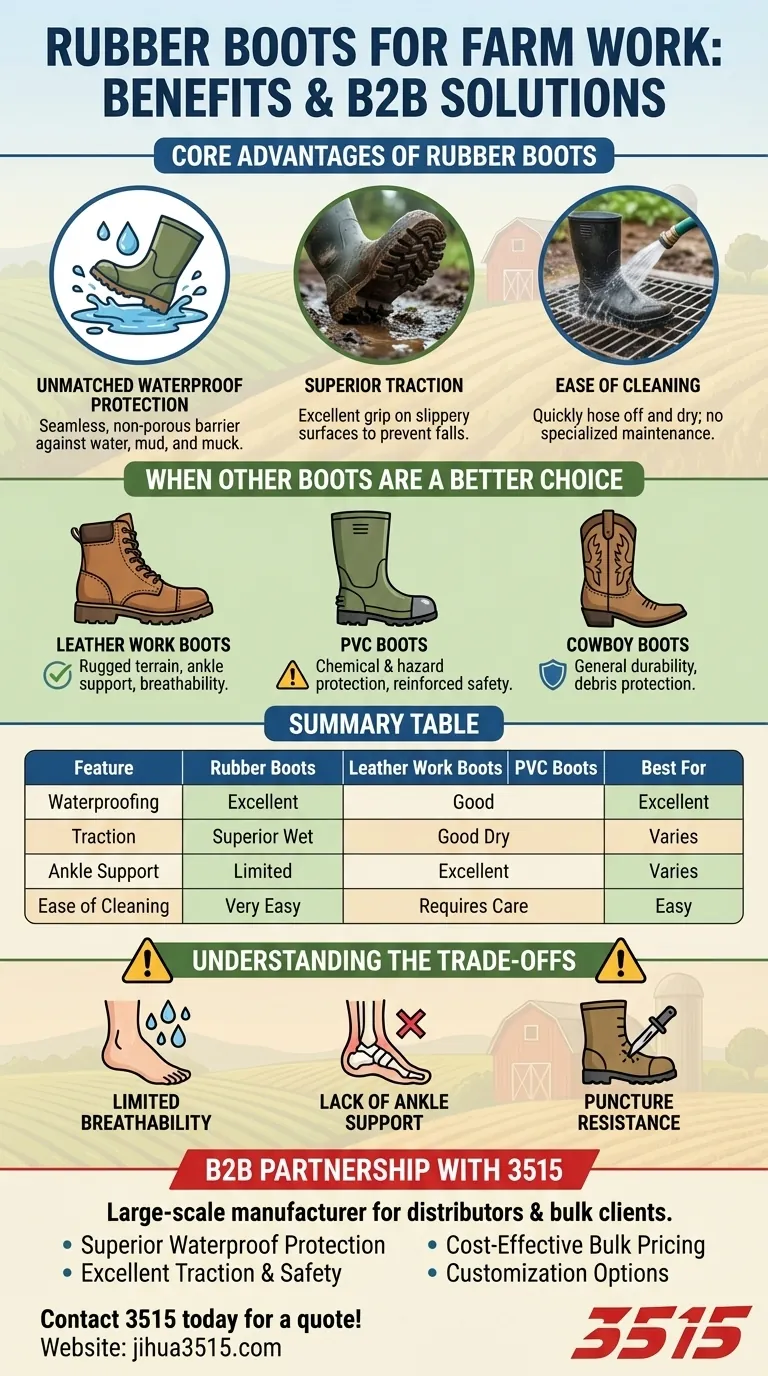For farm work, the primary benefits of rubber boots are their completely waterproof design, excellent grip in wet conditions, and how easily they can be cleaned. Their seamless construction is uniquely suited for tasks involving mud, water, or muck, keeping your feet dry and clean in the harshest environments.
While many boots offer durability, rubber boots are the definitive choice for any task involving significant moisture. Their core advantage lies in their impermeable, one-piece construction, which provides a level of water protection that stitched leather or fabric boots cannot match.

The Core Advantages of Rubber Boots
Rubber boots, often called Wellington boots, serve a specific and critical function on a farm. Their design prioritizes protection from the elements over other factors.
Unmatched Waterproof Protection
A key benefit is their seamless and non-porous material. Unlike leather boots that have seams and can eventually soak through, rubber boots form a complete barrier against water, mud, and manure.
This makes them ideal for power washing equipment, working in flooded fields, or cleaning stalls.
Superior Traction in Wet Conditions
The soles of rubber boots are designed for excellent grip on slippery surfaces. The deep lugs and soft rubber compound help prevent slips and falls in mud, wet concrete, or slick grass, enhancing safety during demanding tasks.
Ease of Cleaning and Maintenance
After a day of work, rubber boots can be hosed off and left to dry. There is no need for the specialized cleaners, conditioners, or careful drying processes required to maintain leather boots. This simple cleanup saves valuable time.
When Other Boots Are a Better Choice
Despite their advantages in wet conditions, rubber boots are not the solution for every farm task. Understanding the strengths of other boot types is essential for choosing the right tool for the job.
For Durability and Ankle Support: Leather Work Boots
Leather work boots are superior for tasks on rough, dry terrain. Their sturdy construction offers better ankle support and protection against abrasions, punctures, and sharp objects. They are also more breathable for all-day wear.
For Chemical and Hazard Protection: PVC Boots
When working with fertilizers, pesticides, or other harsh substances, PVC (polyvinyl chloride) boots are the safer choice. They offer higher chemical resistance than standard rubber and often come with reinforced features like steel toe caps for impact protection.
For All-Around Rugged Use: Cowboy Boots
While a traditional choice, cowboy boots offer good durability with their thick leather and a high shaft that protects against debris. However, they typically lack the specialized waterproofing of rubber boots and the safety features of dedicated work boots.
Understanding the Trade-offs
Choosing rubber boots means accepting a specific set of compromises. Being aware of these limitations is crucial for safety and comfort.
Limited Breathability
The same waterproof quality that keeps moisture out also traps sweat in. During long hours or in warm weather, rubber boots can become uncomfortable and lead to damp feet, which can cause blisters and other issues.
Lack of Ankle Support
The flexible nature of rubber provides very little of the rigid ankle support found in a well-constructed leather boot. This increases the risk of twists or sprains when navigating uneven or rocky ground.
Puncture Resistance
A standard rubber boot offers minimal protection against sharp objects like nails, broken glass, or sharp rocks. For work in debris-filled areas, a boot with a reinforced sole is a safer alternative.
Making the Right Choice for Your Task
Ultimately, the best boot is the one that matches the specific demands of your work environment.
- If your primary focus is working in wet, muddy, or mucky conditions: Choose rubber boots for their absolute waterproofness and simple cleanup.
- If your primary focus is all-day comfort on rugged, dry terrain: Choose leather work boots for their superior support, breathability, and durability.
- If your primary focus is safety around chemicals or heavy equipment: Choose PVC boots, specifically looking for models with steel toes and high chemical resistance ratings.
Selecting the right boot for the specific task at hand is a foundational step toward a safer and more productive day on the farm.
Summary Table:
| Feature | Rubber Boots | Leather Work Boots | PVC Boots |
|---|---|---|---|
| Best For | Wet, muddy, mucky conditions | Dry, rugged terrain, all-day wear | Chemical handling, safety hazards |
| Waterproofing | Excellent (seamless) | Good (requires maintenance) | Excellent (chemical resistant) |
| Traction | Superior on wet/slippery surfaces | Good on dry terrain | Varies by model |
| Ankle Support | Limited | Excellent | Varies by model |
| Ease of Cleaning | Very Easy (hose off) | Requires care/conditioning | Easy to clean |
Need Durable, High-Performance Rubber Boots for Your Farm or Business?
As a large-scale manufacturer, 3515 produces a comprehensive range of waterproof footwear, including the specialized rubber boots perfect for the demanding conditions described in this article. We provide high-quality, reliable footwear solutions for distributors, brand owners, and bulk clients.
Partner with us to get:
- Superior Waterproof Protection: Boots designed with seamless, non-porous materials to keep feet dry.
- Excellent Traction & Safety: Outsoles engineered for maximum grip in mud and wet conditions.
- Cost-Effective Bulk Pricing: Competitive rates for large-volume orders.
- Customization Options: Tailor styles, logos, and specifications to meet your market's needs.
Let us help you equip your customers with the right footwear for the job.
Contact 3515 today for a quote and to discuss your specific requirements!
Visual Guide

Related Products
- Factory-Direct Wholesale Canvas Boots with High-Traction Rubber Soles
- Premium KPU Injection Athletic Style Safety Shoes
- Factory Direct Wholesale Rain Boots Durable Waterproof & Fully Customizable
- Premium Flame-Retardant Waterproof Safety Boots and Shoes
- High Performance Fire-Retardant Waterproof Safety Boots
People Also Ask
- What is a vulcanized sole? Discover the Secret to Superior Flexibility and Grip
- What types of work environments are hiker-style rubber outsoles best for? Ideal for Outdoor & Industrial Safety
- What types of rubber are typically employed in non-slip footwear soles? Your Guide to Maximum Grip and Safety
- What are the advantages of rubber soles in safety boots? Unbeatable Grip & Durability
- Why is rubber a popular material for shoe soles? Unbeatable Grip, Durability & Value



















